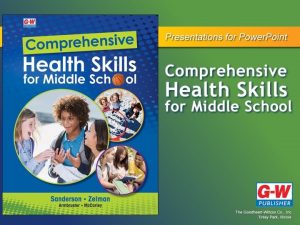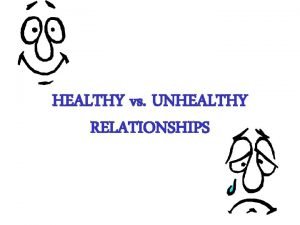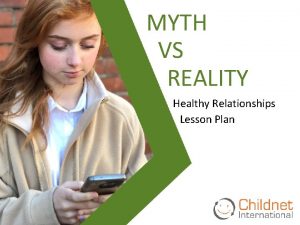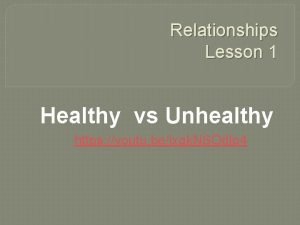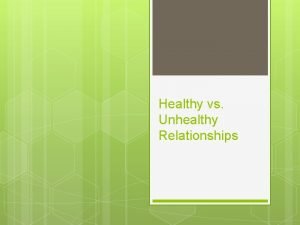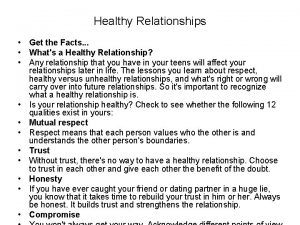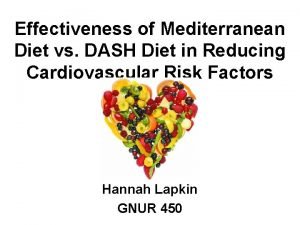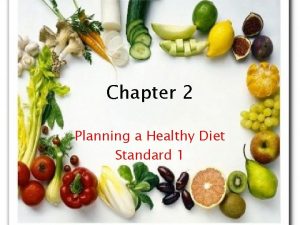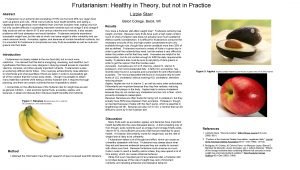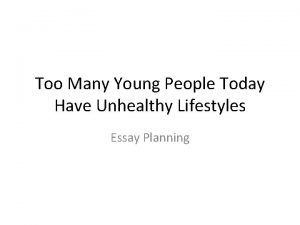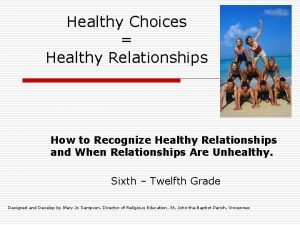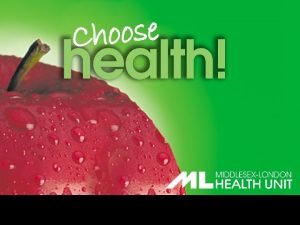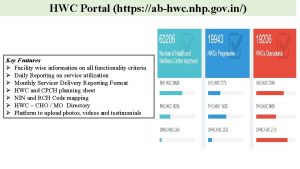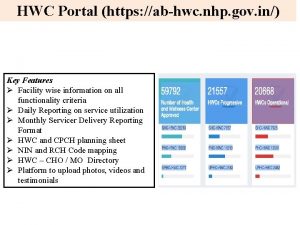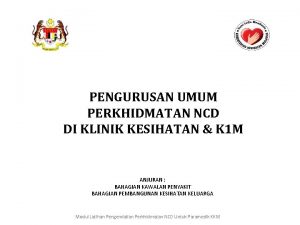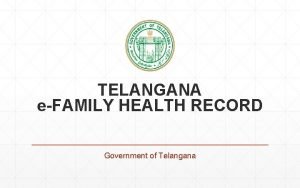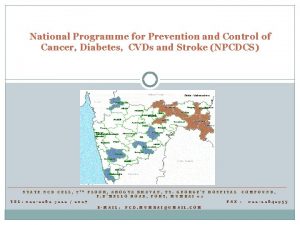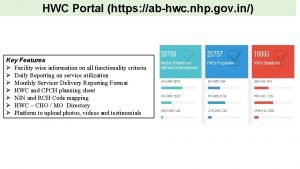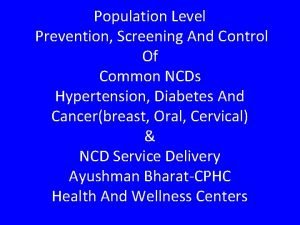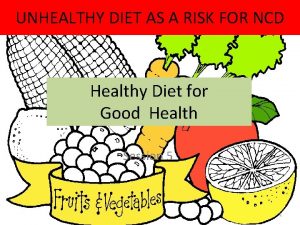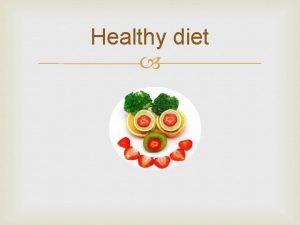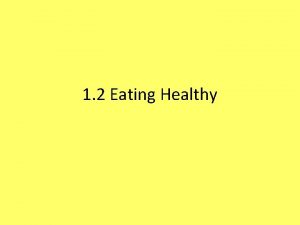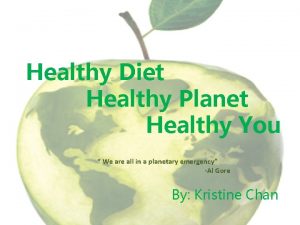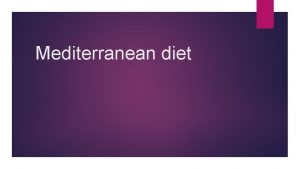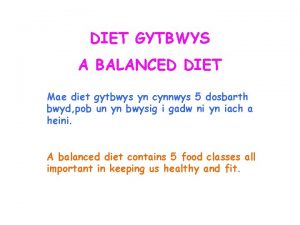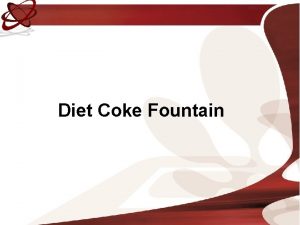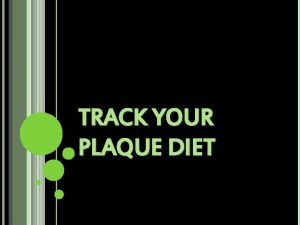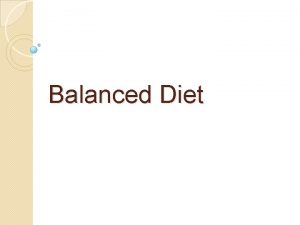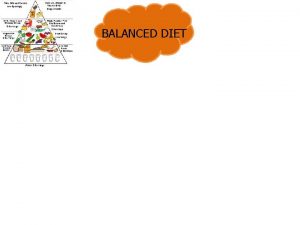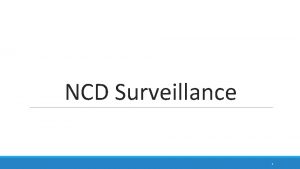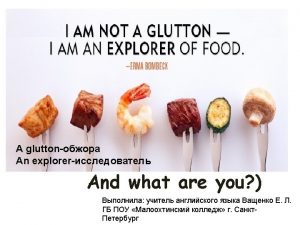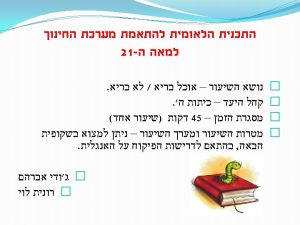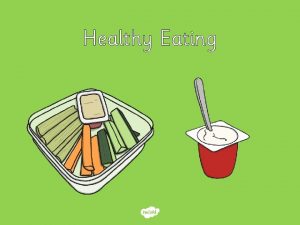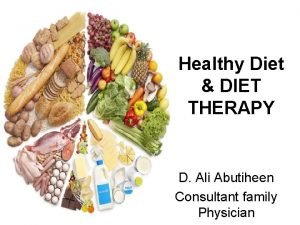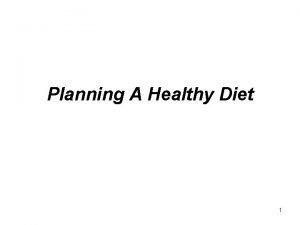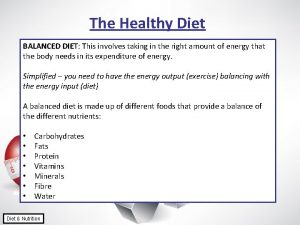UNHEALTHY DIET AS A RISK FOR NCD Healthy













































- Slides: 45

UNHEALTHY DIET AS A RISK FOR NCD Healthy Diet for Good Health Session 5 1

AIM The Counselor would be able to recognize the importance of diet and its relationship to other risk factors and non communicable diseases and address dietary habits in primary care. 2

LEARNING OBJECTIVES A. To improve the Counselor’s understanding about the importance of diet B. To improve the Counselor’s understanding about unhealthy diet as a risk factor of NCDs. C. To help the Counselor to assess unhealthy dietary practice and to promote healthy dietary practices through behavior change D. To plan health promotion activities in the community on diet and linkages to risk factors and NCDs 3

LEARNING OBJECTIVE A. To improve the Counselor’s understanding about the importance of diet 4

A WORKSHEET 24 HOUR RECALL Can you recall and write down in a worksheet, what you ate in the last 24 hours? e. g. What did you eat (or drink) for breakfast, lunch, snack time and dinner? 5

HEALTHY DIET Grains/cereals (rice, wheat, oats and corn), millets (ragi and jower), roots (carrot, potato, ginger and onion), jaggery/honey/sugar and oil/ghee Body Building Food Soya beans, milk and milk products, meat, fish, eggs and nuts Fruits and vegetables (especially raw), whole grains and pulses. Energy Giving Food Fiber Food Protective Foods Fruits, vegetables and green leafy vegetables. 6

UNHEALTHY DIET • High intake of salt and oily food • Low intake of vegetables and fruits • Excess intake of fast foods Junk food: Pre-prepared or packaged food having low nutritional value due to high trans fat (fats that raise bad cholesterol , sodium and sugar e. g samosas, burgers, colas, bakery items 7

A WORKSHEET Contd. 24 HOUR RECALL Now write down, what is healthy and unhealthy diet from your 24 hour recall list 8

B Is a healthy diet the same for all age groups? (E. g. elderly, adults, children) 9

DIET FOR DIFFERENT GROUPS MORE ENERGY FOOD for toddlers, children and pregnant women MORE FIBER FOOD QUANTITY OF FOOD NEEDED TO MEET NUTRIENT REQUIREMENTS VARY WITH AGE MORE PROTECTIVE FOOD for children, adolescents, pregnant women, adult and elderly for pregnant women, adults and elderly MORE BODY BUILDING FOOD for adolescences, pregnant women, toddler and adults 10

SUMMARY POINTS • A blend of four kinds of food is essential for healthy diet • Avoid unhealthy food • Different age groups have different nutritional needs 11

LEARNING OBJECTIVE B. To improve the Counselor’s understanding about diet as a risk factor for NCDs 12

B How is diet associated with NCDs? 13

EVIDENCE ON DIET & NCDs 90% of type 2 diabetes is related to unhealthy diet CARDIOVASCULAR DISEASES DIABETES CANCER COMMON MENTAL DISORDERS CHRONIC RESPIRATORY DISEASES Low intake of fruits, vegetables and cereal grains increases risk of cancer. UNHEALTHY DIET Excessive coffee consumption increases BP, causes abnormalities in heart beat, elevates level of total and bad cholesterol, triglycerides and heart diseases. High salt intake is a risk factor for hypertension TOBACCO ALCOHOL STRESS PHYSICAL INACTIVITY 14

UNDER NUTRITION - STILL A MAJOR PROBLEM IN OUR COUNTRY Poor growth Effects on health of the next generation Developmental delay Reduced fertility UNDER NUTRITION Poor resistance to infection Mental dullness Greater chance of chest infections Heart failure 15

DISEASE RISK FROM EXTRA WEIGHT

B How is diet associated with other risk factors? Is there a connection between diet and physical activity, alcohol, tobacco and stress? 17

LINKAGES OF DIET TO OTHER RISK FACTORS PHYSICAL ACTIVITY Risk for chronic diseases is influenced by what people eat and how much physical activity they do. STRESS Under stress people eat differently. Some people eat more and some less. When people are stressed they tend to have irregular eating habits and to eat more of junk food (samosas, chips) ALCOHOL & TOBACCO Tobacco use can impair appetite and lead to irregular eating practices. When combined with alcohol, stress and poor eating, the risks for NCDs can increase. 18

SUMMARY POINTS • Unhealthy diet leads to NCDs • Unhealthy diet is interrelated to other risk factors 19

LEARNING OBJECTIVE C. To help the Counselor to assess unhealthy dietary practice and to promote healthy dietary practices 20

A CASE STUDY Munna is 35 years and works in the local school canteen. His weight is 95 kgs and height is 170 cms. He says he feels exhausted and tired and takes leave often. He comes to the Health Centre with his wife and meets the Medical Officer. The Medical Officer refers Munna to the Counselor. He says he loves to eat potato chips, chaat and samosas which are sold in the canteen. His wife complains that he does not eat enough of vegetables, fruits and pulses. • How do you assess diet practices in Munna? • What do you do to help Munna make a change? 21

THREE STEPS TO OFFER HELP ASK ASSIST Involve the patient including family/ significant others in the three steps ARRANGE 22

RAPPORT BUILDING • Counselor to patient: Could you tell me what brings you here? • Patient: I came here to get treatment for my breathing problems and have not gone to work… • Counselor: Can you tell me more about your breathing problems? (Patient describes the difficulties he faces in daily life) • Counselor: I can understand your difficulties at present like your breathing problems and that you have taken leave. All this must be hard for you. We can discuss how to help you to manage your life in healthy ways. Would you like that? • Patient: Okay…. • Counselor: I would like to ask a few questions before we discuss ways to move forward. • Patient: Yes 23

STEP 1: ASK When to ask? The Counselor should ask about dietary habits to ALL patients who report with health problems (this includes men and women). 24

ASK Contd. How to ask? • Counselor: You have been given medicines for your breathing problems. You also need to reduce your weight use healthy ways of managing it. Some people often have problems of breathing due to weight issues. This in turn may be related to what a person eats. Can I ask you a few questions about your diet? • Patient: Ok…. • Counselor: Can you tell me what you ate in the past 24 hours? Your breakfast, lunch, snack time and dinner…. • Patient: I had only rice and sambar for lunch yesterday. I ate a vada from the canteen in the evening. I bring samosas for my children and ate one last night before dinner. I drank 4 cups of coffee • Counselor: Ok. Is this your diet on a normal day? • Patient: Most of the time I eat this way as I work in the school canteen… 25

ASK Contd. What to Ask? • About routine diet and other eating habits (use 24 hour recall method). • Use checklist to assess unhealthy diet. • Check Body Mass Index (BMI) BMI= weight (kilogram) ÷ height (meters) 2 26

Check list (Unhealthy diet) ASK Contd. Sl No Food items 1. I drink pepsi/cola/sprite/soda/other aerated drinks. I use excess sugar I use excess salt I eat papads/pickles/chips/salted biscuits I use ghee/butter/vanaspathi I eat fried foods (like chips, kabab, samosa, vada, gobi manchurian, fried fish, chats, bonda) I eat junk food (like chocolates, ice cream, chips) I eat polished items (white rice and maida) I eat red meat I eat fast/processed food I drink excess coffee and tea (more than 4 to 6 cups) I drink tea/coffee at least for one hour before and after meals. Others (if any, mention) 2. 3. 4. 5. 6. 7. 8. 9. 10 11. 12. 13. Yes/No If yes, then how often 27

STEP 2: ASSIST Use counseling skills for behavioral change • Discuss BMI score (traffic light) and unhealthy eat practices • Link medical condition to unhealthy eating practices • Keep focus on present health condition. • Provide a strong personalized message • Use balance sheet to motivate the patient • Promote healthy diet 28

TRAFFIC SIGNAL Contd. Underweight (<18. 5) & Obese (>30): Brief counseling & referral to Medical Officer Overweight 25 to 29. 9: Brief counseling Normal 18. 5 to 24. 9: Educate about health consequences of unhealthy diet 29

LINK MEDICAL CONDITION TO UNHEALTHY EATING PRACTICES HEART RELATED PROBLEMS s of od ck fo La tive ec ot e fib of ck ood f La r CANCER DIABETES pr gy r ne e f od o k g fo c La vin gi contd. dy s o b od f o fo k g c La ildin bu OBESITY & EARLY AGING 30

USE A BALANCE SHEET BENEFITS AND PROBLEMS ASSOCIATED WITH MY DIET GOOD THINGS ABOUT MY PRESENT DIET? • Helps me to be with friends • I love samosas and other snacks BAD THINGS ABOUT MY PRESENT DIET? • I feel worse the next day • I have severe stomach pain • I can breathe properly and can’t play sports • I feel like vomiting • My friends tease me about my weight • My weight will increase • I look fat • I get angry when there are no snacks and fried items • I run out of money buying junk food • My family gets very upset when I eat junk food 31

USE A BALANCE SHEET BENEFITS AND PROBLEMS ASSOCIATED WITH MY DIET GOOD THINGS WHEN I EAT A HEALTHY DIET? • I feel great each day and got to work regularly • I eat and sleep well • My weight will reduce • I will look fresh, younger and slim • I can play games • I can save money and avoid medical bills and feel healthy BAD THINGS ABOUT GIVING UP MY DIET? • I will have to give up all the food I love to eat • My doctor has asked me to lose weight and I can’t follow the diet changes • I will not be able to have fun and enjoy life like I did before. 32

PROMOTE HEALTHY DIET: Meal planning Early Morning Tea-with milk Small quantity of nuts (peanuts/chana/ badam) Breakfast Upma/Rice bath/3 Idlies/2 Dosas 1 glass skimmed milk 1 egg/vegetable curry/pulses Mid-day Lunch Tea Dinner 1 seasonal fruit 1 bowl raw vegetable salad (e. g. cucumber) Tea/ Coffee Salad fruits 1 big cup green leafy vegetable (palya) 2 Biscuits /seasonal fruits Vegetable (palya) fish/dal 1 cup 1 cup dal/2 chicken/ fish pieces Raita/curd (use skimmed milk) 2 rotis/rice 2 medium cup 2 rotis (wholewheat) /Rice 2 medium cup (partially or unpolished) Drink minimum of 1. 5 to 2 liters of water every day to keep your body well hydrated 33

PROMOTE HEALTHY DIET Healthy Plate 34

INVOLVE THE FAMILY Involving the family member who takes decisions about what people in the family eat is important Addressing family members’ nutritional needs and resources and personalized advice about diet is important Family Educating family members about their diets is important Involving the family member who makes decisions about what food items to buy is important 35

WHAT SHOULD WE EAT? • Eat plenty of fruits and vegetables • Eat plenty of cereals, millets and pulses • Drink fresh lime, butter milk, coconut water and fresh juice • Eat homemade foods • Drink water • Salt intake should not be more than 1 tea spoon per day. If the patient is hypertensive restrict salt intake to ½ tea spoon per day 36

WHAT SHOULD WE AVOID EATING? • • • Aerated drinks like pepsi, cola, sprite, soda and other coloured drinks. Excess salt and refined sugar Papads, pickles, chips and salted biscuits Ghee, butter and vanaspathi Fried foods like chips, kababs, samosa, mixtures, vada, gobi manchurian, fried fish, chats bajis and bondas Junk food like chocolates, ice creams and chips Polished items such as white rice and maida Red meat Fast/processed food Excessive use of coffee and tea Tea and coffee at least for one hour before and after meals. 37

contd. • Diets should be individualized and tailor-made for each patient (e. g. persons with diabetes & heart diseases may need specialised dietary advice) • The Medical Officer should be consulted before diet is discussed with the patient. 38

√ AN EXAMPLE OF DIET FOR DIABETES • Grains, millets, carrot, beetroot, milk and milk products, fish and egg yolk • Fried items • Honey, jaggery, jams, sweet in any form • Fruits high in sugar like banana, grapes, mangoes, pineapple • Foods like potato, sweet potato • Plenty of buttermilk, lime juice, leafy vegetables, salads, cucumber &soups • Oil should be less than 3 to 4 tablespoons a day • Fruits such as apple, orange, mosambi, papaya can be eaten in small amounts. 39

STEP 3: ARRANGE • Refer patient to the Medical Officer in case of medical assistance for health related issues. • Inform patient about follow- up and monitor progress. • Make home – visits with the help of the Community Health Worker. 40

A WORKSHEET PLAN MY MEAL TODAY Plan a meal for a day using the meal planning chart and healthy plate. 41

SUMMARY POINTS • Ask dietary practices • Check BMI • Link medical condition to unhealthy eating practices • Use balance sheet to motivate the patient • Promote healthy plate and meal planning • Refer patient to Medical Officer for health related issues • Follow up to monitor progress with help of the Community Health Worker 42

LEARNING OBJECTIVE D. To plan health promotion activities in the community on diet and linkages to risk factors and NCDs 43

A WORKSHEET FOOD EXHIBITION • Choose a specific group in the community and plan a health promotion programme (youth, self - help groups, schools, women, farmers, workers, village panchayat, village health and sanitation committee etc. ) plan a food exhibition. • The benefits of different foods should be listed • Give simple recipes for healthy diet using locally available food produce. • Specify duration, content, methodology 44

WRAP UP • What do you take back at the end of this module? • As a Counselor, name at least 2 things you will do in the field 45
 Military power and control wheel
Military power and control wheel Define the relationship chapter 14
Define the relationship chapter 14 Scenarios of healthy and unhealthy relationships
Scenarios of healthy and unhealthy relationships Healthy relationships lesson plans
Healthy relationships lesson plans Healthy vs unhealthy relationships worksheet
Healthy vs unhealthy relationships worksheet Healthy vs unhealthy weight loss
Healthy vs unhealthy weight loss Healthy relationship scenarios
Healthy relationship scenarios Healthy vs unhealthy dating relationships
Healthy vs unhealthy dating relationships Facts about healthy relationships
Facts about healthy relationships Dash vs mediterranean diet
Dash vs mediterranean diet Credit risk market risk operational risk
Credit risk market risk operational risk Chapter 2 planning a healthy diet
Chapter 2 planning a healthy diet Is fruitarian diet healthy
Is fruitarian diet healthy Healthy community poster
Healthy community poster Healthy soil healthy life poster ideas
Healthy soil healthy life poster ideas Healthy nurse healthy nation
Healthy nurse healthy nation Healthy food healthy mind journal
Healthy food healthy mind journal Tim too many young people are
Tim too many young people are Unhealthy communication
Unhealthy communication The problem of emotionally unhealthy spirituality
The problem of emotionally unhealthy spirituality Unhealthy symbiotic relationship
Unhealthy symbiotic relationship Unhealthy boundaries definition
Unhealthy boundaries definition Kfcofgs
Kfcofgs Hwc. nhp. gov. in
Hwc. nhp. gov. in Https//ab-hwc.nhp.gov.in
Https//ab-hwc.nhp.gov.in Klinik paramedik
Klinik paramedik Ncd telangana gov in app
Ncd telangana gov in app Ncd
Ncd Ncd dh amravati
Ncd dh amravati Schoology ncd
Schoology ncd Ab. hwc. nhp. gov. in
Ab. hwc. nhp. gov. in Ncd anm login
Ncd anm login Redogör för vad psykologi är
Redogör för vad psykologi är Claes martinsson
Claes martinsson Gumman cirkel sång
Gumman cirkel sång Svenskt ramverk för digital samverkan
Svenskt ramverk för digital samverkan Dikt med fri form
Dikt med fri form Etik och ledarskap etisk kod för chefer
Etik och ledarskap etisk kod för chefer Antikt plagg i rom
Antikt plagg i rom Tidböcker
Tidböcker Vilken grundregel finns det för tronföljden i sverige?
Vilken grundregel finns det för tronföljden i sverige? Fspos vägledning för kontinuitetshantering
Fspos vägledning för kontinuitetshantering Ministerstyre för och nackdelar
Ministerstyre för och nackdelar Jätte råtta
Jätte råtta Sju principer för tillitsbaserad styrning
Sju principer för tillitsbaserad styrning Plats för toran ark
Plats för toran ark

